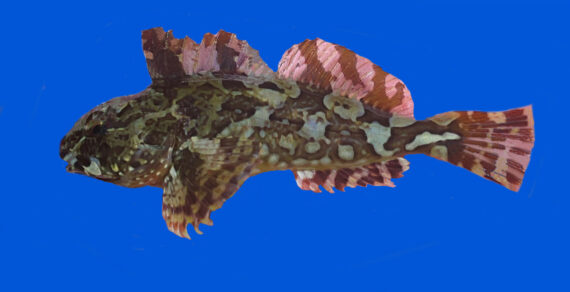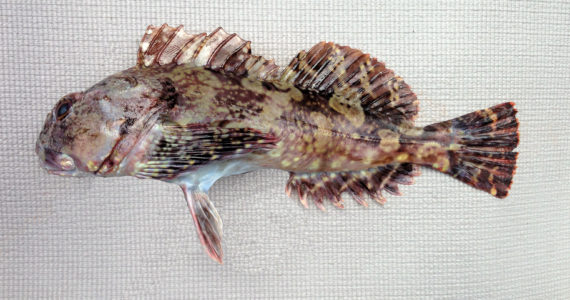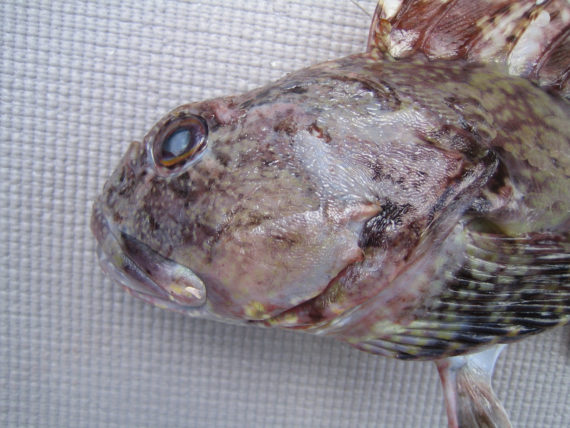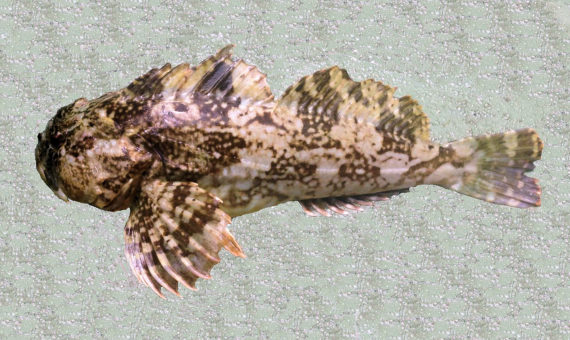Cabezon, Scorpaenichthys marmoratus
 Cabezon, Scorpaenichthys marmoratus, Juvenile. Fish caught from coastal waters off Brookings, Oregon, August 2021. Length: 24 cm (9.4 inches). Catch, photograph and identification courtesy of Luke Ovgard, Klamath Falls, Oregon.
Cabezon, Scorpaenichthys marmoratus, Juvenile. Fish caught from coastal waters off Brookings, Oregon, August 2021. Length: 24 cm (9.4 inches). Catch, photograph and identification courtesy of Luke Ovgard, Klamath Falls, Oregon.

 Cabezon, Scorpaenichthys marmoratus, Male. Fish provided by the commercial fishermen of the greater San Diego area, San Diego, California, October 2014. Length: 34 cm (13 inches).
Cabezon, Scorpaenichthys marmoratus, Male. Fish provided by the commercial fishermen of the greater San Diego area, San Diego, California, October 2014. Length: 34 cm (13 inches).
 Cabezon, Scorpaenichthys marmoratus. Fish caught from coastal waters off Santa Cruz, California, July 2016. Length: 48 cm (19 inches). Catch, photograph and identification courtesy of Andrew Hansen, Santa Cruz, California.
Cabezon, Scorpaenichthys marmoratus. Fish caught from coastal waters off Santa Cruz, California, July 2016. Length: 48 cm (19 inches). Catch, photograph and identification courtesy of Andrew Hansen, Santa Cruz, California.
The Cabezon, Scorpaenichthys marmoratus, is a member of the Cabezon or Scorpaenichthyidae Family, and is known in Mexico also cabezon (large head). The Cabezon is the only family member and the only species of the Scorpaenichthys genus, and it is found in Mexican waters of the Pacific Ocean.
The Cabezon has a large bulbous head and a stout body. They are dimorphic with males featuring predominately marbled reddish-brown earth tones and females being greenish-brown. Their coloration is lighter ventrally and they can change colors to blend into their backgrounds. Females are larger than males. They have a disproportionately large head and a large broad mouth equipped with numerous small teeth. They have a stout spine before their eyes and a short cirrus on their snout. Juveniles have a pair of branched cirri above each eye that disappear with maturity. Their anal fin has 11 to 14 rays; their caudal fin is rounded; and, their dorsal fin is continuous with the first portion having 8 to 12 spines and the second portion being higher and having 15 to 18 rays. They have 16 to 22 gill rakers. They do not have scales.
The Cabezon is found in shallow waters in rocky areas associated with reefs, boulders, kelp beds, and eel grass at depths up to 232 m (760 feet). They reach a maximum of 99 cm (3 feet 2 inches) in length and 11 kg (25 lbs) in weight. As of January 1, 2024, the International Game Fish Association world record stood at 10.4 kg (23 lbs 0 oz), with the fish caught in coastal waters off the State of Washington in August 1990. They spend the majority of their time as solitary demersal individuals resting on the bottom and are colored to blend into their backgrounds. They feed on crustaceans, fish, fish eggs and mollusks. They spawn in coastal rock outcrops with each female laying between 50,000 and 150,000 purple to blue-green, pink or white eggs that attach themselves to rocky structures and are then guarded by males for four to six weeks until they hatch. The larvae are pelagic and develop into silvery fish that hide within ocean debris and eventually return and settle out in tidal pools before moving to reefs and kelp forests. They have a lifespans of nineteen years.
The Cabezon is a resident of Mexican waters of the Pacific but has a limited distribution being found from Punta Abreojos, Baja California Sur, northward along the central and northwest coasts of Baja.
The Cabezon is similar in appearance to the majority of Scorpionfish but lacks head spines. Its smooth head and unique marbled mottling make it easy to identify.
From a conservation perspective the Cabezon has not been formally evaluated. Although they are a major component of the shallow water environment, they are poorly regulated and thus prone to overfishing. They are a favorite of pier anglers and while spawning the males become sitting ducks for recreational anglers as they sit on their nests. They are also targeted by spear fishermen during the spawning period. The Cabezon is caught and sold by commercial fishermen on a limited basis. They are considered an excellent food fish, however, their roe is toxic to humans. The Cabezon was an important component of the diet of Native Americans.